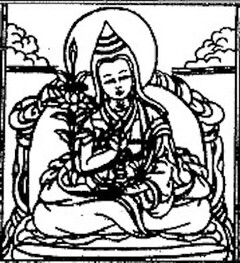Samaya Commitment
Vows & Commitments › Samaya | Practices › Following a Teacher | Deities › Mañjuśrī | Tibetan Masters › Lala Sonam Chödrup

Lala Sonam Chödrup
A Brief Guide to Samaya Commitment
by Lala Sonam Chödrup
Homage to Vajrasattva!
Whenever we receive an empowerment for any yidam deity, the samaya commitment is crucial to the ripening of the real essence of the empowerment within our mindstream.
Consider an empowerment for Mañjuśrī. In general terms, to avoid the ten non-virtuous actions and carry out the ten virtuous actions serves as a foundation. Then, on that basis, you must regard the guru as Mañjuśrī in person, and observe the following:
Commitments Related to Enlightened Mind
Never forget to cultivate loving kindness, compassion and relative bodhicitta, or to meditate on absolute bodhicitta, emptiness and clear light. Guard the guru’s wisdom mind by avoiding anything that might disturb it, as if your very life depended on it. Cherish, as you would your own heart, whatever is agreeable to the guru’s wisdom mind, and exert yourself continually in the yoga in which the guru, Mañjuśrī and your own mind merge inseparably.
Commitments Related to Enlightened Speech
Continuously recite dhāraṇī mantras, such as the Arapatsa.[1] Consider the speech of the guru — even if he or she is an ordinary being — as the Buddha’s own word, because the guru surpasses the buddhas in terms of kindness. Avoid contradicting anything the guru says, even if it is seemingly unrelated to the Dharma. And it is crucial that you do not deviate even slightly from any instructions that are directly related to the Dharma. Consider any critical comments or reprimands as a Dharma teaching and take them to heart. If the guru is in residence nearby, do not embark on anything independently without seeking his or her approval. Whatever the guru says, guard it carefully as if your very life were at stake, and carry it out unfailingly.
Commitments Related to Enlightened Body
View the guru as the very essence of Mañjuśrī in form and visualize him or her at the crown of your head or in the centre of your heart. Never do anything that might harm even so much as a single pore of the guru’s body. Avoid even stepping on the guru’s shadow. Regard all the guru’s physical actions positively. Keep representations or symbols of the enlightened body, speech and mind of the guru and Mañjuśrī , and do not show them to those who do not share the same commitments. Practise the yoga of visualizing your own body as the deity.
In general, you must train in the pure perception of recognizing how all sentient beings, in their inherent purity, are inseparable from Mañjuśrī’s enlightened body, speech and mind. Cherish especially all those who hold the same commitment, for they are like your own vital energy. Carry out whatever is agreeable to the guru’s body, speech and mind, and practise the three means of bringing delight.[2] If there is anyone who acts in a way that conflicts with the guru’s body, speech and mind, or who holds wrong views, or who is harmful, do not react with anger, but use various means to avert any harm. Should this fail, avoid sharing the meaning of mantra with such people. Do not stay in the same place as anyone whose conduct conflicts with your own.
If you can practise in this way, you will swiftly gain accomplishment in this life, and there will be no obstacle to the fulfilment of your wishes. This is the point on which all that is positive in this and future lives depends, so it is crucial that you maintain your commitments without ever allowing them to degenerate. It is said that if students receive the guru’s threefold kindness[3] but then fail to maintain the samaya commitments, whatever they do from then on — all further projects and activities — will be none other than a mistaken path.
This is just a summary. You must look elsewhere for an elaborate explanation, but there are infinite texts on the topic.
In response to a request from the attendant who holds the name of tulku, Losal Pema Özer, this was written by the mantra practitioner Rigtsal Dorje.
| Translated by Adam Pearcey, 2017.
Version: 1.1-20210804
-
i.e., the mantra Oṃ arapacana dhīḥ pronounced by Tibetans Om arapatsana dhih. ↩
-
The three ways of delighting the guru are mentioned in The Words of My Perfect Teacher in Chapter 6, p.145 ‘How to Follow a Spiritual Friend’: “The best way is known as the offering of practice, and consists of putting whatever he teaches into practice with determination, disregarding all hardship. The middling way is known as service with body and speech, and involves serving him and doing whatever he needs you to do whether physically, verbally or mentally. The lowest way is by material offerings, which means to please your teacher by giving him material goods, food, money and so forth.” ↩
-
That is, the kindness of granting empowerment, oral transmission and pith instructions. ↩